When approached strategically, social media is a powerful tool for building a strong workforce. Since a whopping 79% of job seekers use it to find employment, your next star employee may be actively seeking opportunities right now.
However, with numerous platforms to comb through, it can be overwhelming to recruit via social media. To ease your online search for top talent, I’ll walk you through its ins and outs, including this channel’s strengths and weaknesses, top-recommended platforms to search, and how to make social media an asset to your hiring process.
What is social media recruiting?
Social media recruitment is the use of platforms like LinkedIn, Facebook, Instagram, Twitter, and others to share job listings, find potential candidates, and connect with industry professionals.
It also involves sharing content that showcases why working for your organization is an alluring proposition. The aim is to generate brand interest and attract qualified applicants.
The advantages of social media recruiting
Because people tend to be more open and honest online, social platforms are great for finding, sourcing, and learning about job candidates. Besides providing a glimpse of people’s interests, views, and expertise, social media recruiting lets you enjoy the following advantages as well.
Access to diverse talent pools
Linkedin alone has over 950 million users in more than 200 countries — all of whom possess a unique skill set. With this diverse pool of talent at your disposal, you’re sure to find your next stellar worker.
Advanced search features on the platforms can also help fill niche roles, which could range from a simple job like a shelf stocker to something as technical as an eCommerce website developer.
Reach younger and more relevant audiences
Social media enables targeted recruitment efforts that engage and cater to professionals relevant to your industry. They even provide access to niche groups and communities whose members possess specialized skills.
Younger demographics commonly use social platforms to find employment opportunities as well. For instance, 62% of Gen Zers found work through social media, while 56% of millennials have done the same.
Lower recruitment costs
Publishing a 30-day listing on an online job board will typically cost you $200 to $500, and that expense can multiply based on the number of platforms you use.
Since social media posts are essentially free, organically promoting open positions using your online presence can significantly cut that cost.
Further boost job listing visibility
Besides pushing job openings and relevant content to countless professionals and job seekers, social platforms let you exponentially increase your reach through paid advertising or listings. With pay-per-click (PPC) options available as well, they’re more cost-effective than online job boards.
For example, according to LinkedIn, their paid job postings help companies attract three times more qualified applicants. Businesses can also dictate their budget, only needing to pay for views from candidates.
Easy screening
Social media allows you to screen candidates before you interact with them in person. You can verify the information they provide and identify indicators of whether or not they’ll fit in your organization.
However, this should only be one component of your process; social media screening should not dictate your final hiring decision.
Find candidates through followers, networks, or referrals
Thanks to online platforms, building a following and a professional network is easier than before. The individuals you cultivate relationships with could then become potential applicants or a source of referrals.
Showcase employer branding
Employer branding conveys the value of joining your company and is a key element for attracting the right talent. It incorporates how employees view you and embodies your overall culture. Social media serves as the perfect channel for openly sharing these aspects, providing you opportunities to show job seekers why your organization is a superb place to work.
Capture passive candidates
Passive candidates are employed individuals who aren’t actively looking for another role. They can be difficult to engage, but a well-established social media presence and employer brand can help move them into your recruitment funnel.
By presenting attractive opportunities on platforms where extensive job research and networking occurs, you can capture the attention of these individuals and draw higher-skilled candidates into your organization.
The drawbacks of social media recruiting
Like any tool that enhances your recruitment efforts, social media does have its disadvantages.
Requires strategic efforts
Making the most of job listings and recruitment content requires more than simply posting on social platforms regularly. Genuine success necessitates a well-thought-out approach tailored to the talent you want.
So, messaging that resonates with C-suite individuals won’t attract middle managers, and what entry-level workers desire won’t necessarily align with that of supervisors. You’ll need to invest in proper research to hone your strategy for the right audience.
Strict budgeting is a must
PPC and view-based pricing structures make paid advertising and listings on social media more cost-effective but, if monitored incorrectly, they can become expensive. This is a risk for businesses of all sizes, but especially for smaller ones with limited budgets.
Different audiences use different platforms
As different platforms cater to diverse user bases, understanding audience demographics and their preferred channels is crucial.
LinkedIn, for instance, is best for reaching millennial workers because they make up the majority of its user base. Additionally, 91% of executives say it’s their first choice for professionally relevant content.
On the other hand, sifting through Reddit is the strategy of choice for filling technical posts since its technology sub-group attracts over 27 million monthly visitors.
To reach Gen Z, it’s crucial you deliver recruitment content through their most-used social platforms, namely:
- Instagram: 76%
- TikTok: 68%
- Snapchat: 67%
Susceptible to bias
Many people openly share their personal lives on social media, and some of these details can put them at a disadvantage. This is partly why the Harvard Business Review dissuades companies from using social platforms to screen candidates and make hiring decisions because of ethical and legal issues.
Atta Tarki, CEO of recruiting firm ECA Partners, even discourages clients from judging candidates’ social media profiles because, “It will result in bias.”
Provides no indication of future performance
Social platforms help recruiters validate a candidate’s work experience and learn about their lifestyles, interests, views, etc. However, those characteristics have no bearing on how a candidate will perform in their role.
Which social platforms are most commonly used for recruitment?

The ideal platform for your recruitment efforts will vary according to your audience or field of expertise. To give you a better understanding, here’s an overview of which portals recruiters most commonly use for different circumstances.
LinkedIn is geared towards professionals and is utilized across many industries. Users create profiles that serve as secondary resumes and leverage their presence on the platform for networking, as well as employment opportunities.
Here, you can post job listings and share content relevant to your industry and company branding. The platform offers paid recruitment tools specifically made for sourcing and connecting with candidates as well.
Facebook boasts close to three billion monthly active users and reaches a broad spectrum of demographics. It lets you share job posts through your business page, as well as content that establishes your brand’s reputation and culture.
The platform’s search functions are also helpful for sourcing talent from industry-related or niche groups. Facebook’s paid advertising is also an option, just in case you want added visibility.
Instagram is a social platform built around sharing visual content. It’s the perfect channel for reaching a younger workforce and building up your employer brand.
Besides sharing job postings with attractive images, you can also post more relaxed content, like Instagram Stories of company events, office tours, and notable employees.
Twitter or X
Twitter, also known as X, enjoys nearly 354 million monthly active users, 52.9% of whom are 25 to 49 years old. Many industry leaders and professionals share their thoughts on the platform as well.
If you have snippets of information relevant to your field or your company, Twitter can be an avenue for sharing and, in turn, building a robust employer brand. It can also serve to disseminate job opportunities and recruitment content.
If you’re looking for candidates, Twitter gives you a glimpse of their interests and values as well. Here, posts and replies are publicly visible, so the content they engage in helps you gauge their organizational fit.
YouTube
Besides being a popular platform among younger demographics, people love videos in general, and YouTube boasts 2.5 billion global users. With such a large following, it’s the ideal place to share long-form content about your company, its values, workplace culture, and employees.
Candidates with a YouTube presence can fit creative roles in your organization as well. These can range from video editors and content creators to digital artists and marketers.
A huge advantage YouTube content possesses is people can share content from the platform across other social media sites too.
TikTok
Known for quirky, short-form videos, TikTok is superb for attracting fresh talent. It works well for publishing relatable content that resonates with viewers on a more personal level and humanizes your employer brand.
As one of Gen Z’s most-used platforms, you’d benefit most from posting snippets of what it’s like to work for your organization and showcasing the best aspects of your culture.
TikTok is great for finding potential employees that can fill creative or marketing roles since its users display clever use of video and an ability to express their message in 90 seconds or less.
Other notable platforms
Though the above platforms are excellent for finding candidates, be sure also to browse niche ones where people with specialized skills and interests gather. Here are some worth looking at.
As previously mentioned, this platform has many groups (Subreddits) that cater to specific fields, like technology. Other groups that can play significant roles in your recruitment efforts include:
- r/RemoteJobHunters: A good source of candidates for remote positions
- r/freelanceWriters: Great for spotting freelance writers
- r/WebDeveloperJobs: Excellent option for finding web developers
These are only a few of Reddit’s countless communities; use the platform’s search function to dive into its wealth of other groups to find people who fit your expectations.
Quora
Quora is dedicated to asking and answering questions and offers a platform where a vast number of users freely share their expertise. Here, you can find various spaces for topics including:
If your brand specializes in any field found on Quora, it can establish itself as an attractive employer by building an active presence on the platform.
Or, if you cross paths with candidates who impart their knowledge, this can indicate they’re experienced enough for specific roles you want to fill.
Among its 482 million monthly users, Pinterest helps 46% of them discover new brands weekly. People collect images, create boards, and follow others as a means of discovering interesting content and inspiring ideas. Popular categories on Pinterest include:
- Art
- Food
- Interior design
- Fashion
- Retail
- Web design
Since 85% of Pinners use the platform to start new projects, cultivating a presence on Pinterest opens opportunities to reach a large pool of talent, particularly for creative roles.
In this space, your company pinboard can showcase your employer branding and work and help you connect with niche audiences.
How to use social media for recruitment

With the pros and cons of social media recruiting covered, as well as what platforms you can utilize, here’s a basic overview of what the process entails.
Step 1: Define your objectives
Clearly defined recruitment goals and target audiences are crucial because they serve as the foundation of your strategies.
First, identify the positions you want to fill and learn what type of messaging resonates with qualified candidates. Set key performance indicators (KPIs) as well to measure whether your recruitment efforts are paying off. Some recruitment goals may look like the following:
- Increase job listing traffic: You’ll need to optimize your listing’s keywords, use relevant hashtags, and share them across multiple platforms to accomplish this objective.
- Diversify candidate pool: To attract candidates from various backgrounds, incorporate inclusive language, connect with assorted communities, and be active on multiple platforms.
- Attract [X] number of applicants: Adding interactive elements like videos, employee testimonials, and clear calls to action (CTAs) can encourage more engagement from job seekers.
Step 2: Select a platform
This step is simple but requires a bit of research. Learn which social platforms are relevant to your industry because, as mentioned, they vary according to audience preference.
To streamline your selection process, create a profile of your ideal candidate, then find out where they’re most active online. For instance, those for creative roles may engage more on visual platforms like Instagram, YouTube, and TikTok, while leaders might frequently share their insights on Twitter and LinkedIn.
Step 3: Build your social media profile
The aim is to create a distinct online image for your brand; you won’t stand out if you’re not recognizable.
A big mistake companies make when searching for candidates is neglecting their own online presence. On social platforms, your profile represents your brand’s identity. It immediately communicates your organization’s mission, values, and goals. If an applicant visits your page and sees no notable content, they’re likely to leave. An empty profile doesn’t instill trustworthiness, so make sure to do the following:
- Input complete information about your organization: This improves SEO and visibility as well.
- Add photos: This provides visual context of your company, its work environment, and employees.
- Post content: Whether it be a blog post link, a video, a photo, or simply your thoughts, share something indicative of your company culture and goals.
Step 4: Post a job listing
Next, it’s time to craft an engaging job post and share it on your chosen platforms. Remember these tips during the creation process:
-
- Make your job title clear: Avoid unorthodox titles. Job seekers will overlook your post if it doesn’t make sense (for example, using “Happiness Guru” for a customer service position).
- A comprehensive job description is crucial: It’s okay to play with words and make your description attractive, but be sure to detail all of the position’s responsibilities, even if it sounds boring.
- Use keywords: If the description is long, applicants might simply skim it. Keywords will grab their attention and make it easier to understand.
- Detail compensation: This is typically the first thing candidates look for, so be transparent and outline their potential salaries and benefits.
-
- Provide contact information: Your applicant may have questions, so enable them to get in touch with you easily.
- Use images: This enhances the visual appeal of your listing, and creates a strong first impression. Make sure all images are job related, such as an infographic showcasing employee benefits and flexible work hours.
Step 5: Detail the application process
Over half (60%) of job hunters say they’ve abandoned an application because of a lengthy or complicated process. To avoid driving away potential hires and move candidates along your recruitment funnel, streamline your procedures.
Set up a dedicated careers page so you can link to it in your social posts for easy submission. Display its URL on your profiles to guarantee accessibility. Additionally, beneath your job listing, clearly communicate what the process will entail by answering the following questions for job seekers:
- What documents should they prepare?
- Where will they submit the requirements for their application?
- How long will it take you to process their documents?
- When will the initial call or interview take place?
- Will they be taking any assessments?
- When can they expect status updates?
- What happens after a successful interview?
How to maximize your social media recruiting efforts
At this point, you now know how to post a proper job listing on social media. But, to give your recruitment process a boost, here are some best practices to follow.
Be responsive
To build relationships with followers and connections, responsiveness is key. Social media acts as your direct line to potential candidates, so, when people interact with you or your content, make sure to engage — they’re already expressing an interest in your organization.
The same goes for applicants: Once they enter your recruitment funnel, maintain communication throughout the process. Always answer questions in a timely manner and ensure they have a seamless experience.
Use multiple platforms
When sourcing talent via social media, having a diverse recruitment strategy is extremely helpful, particularly when filling different job roles. To widen your reach, establish an online presence on a variety of platforms that your target audiences and niches use.
For instance, if you’re looking for a creative director, you may want to create a job post and reach out to people on LinkedIn, Instagram, YouTube, Quora, and Pinterest.
Personalization is key
After getting in touch with hundreds of candidates, it’s understandable you may mistakenly send the wrong message to one. However, generic communications are a huge turn off for everyone.
To express genuine interest and respect, always tailor your message to each potential employee and make it attractive. It’s imperative you start with a positive first impression to establish a strong connection immediately.
Employ relevant filters
Platform-specific filters narrow down your search and simplify the process of spotting qualified candidates. They help recruiters sort candidates by location, experience, occupation, etc. So, once you’ve developed a profile for your perfect candidate, couple it with the right filters to speed up your search.
Utilize hashtags
Hashtags make your job listings easier to find, so look for ones that potential candidates use during their job search and incorporate them.
For example, you could try “#HRJobs” for a social media post containing a position in human resources. It’ll take a bit of research, but finding the right hashtags is worth it to widen your selection pool.
Don’t rely on groups
Social media groups are either open or private communities where people connect and share their expertise. However, marketers also use them to promote their company’s content. As a result, finding legitimate, experienced candidates within a pool of group members that includes expert wannabes and marketers becomes a challenge.
Groups may be great for accessing talent, but don’t lean on them heavily; they shouldn’t be your primary source of qualified individuals.
Move to email when necessary
When conversing through social media messages and comments, keep your responses succinct. However, when exchanges become more detailed, a move to a different communication channel may be needed.
For example, an applicant might have questions about your organization, a job opening, and the application process. So, you could ask them to continue your discussion through email instead. This will allow you to craft private, personal, and professional messages that aren’t constrained by character limits or public scrutiny.
Invest in internal branding
Internal branding is all about promoting company values and culture among your employees, but that has an external effect as well: Satisfied, loyal employees can become ambassadors who gladly share their experiences and ideas with family, friends, and peers — and 88% of people trust brand recommendations from people they know the most.
Having a strong internal brand improves your company’s culture and can encourage employees to talk about you online. This, in turn, strengthens your employer brand as well and can attract potential candidates.
Shoot recruitment videos
You can greatly improve a job listing’s performance and attract 36% more applications just by incorporating a recruitment video. Luckily, nearly all the social platforms I’ve discussed allow you to include them in your posts.
Highlight the job’s perks and associated responsibilities, as well as what makes your company an excellent place to work. Your video’s format should also depend on each platform where you’ll post it. Long-form content, for instance, is ideal for Facebook and YouTube, while short videos are best on Instagram and TikTok.
Incorporate online assessments
Including web-based assessments in your social media recruitment process helps you pinpoint qualified applicants and gauge their hard and soft skills. Utilize them early in your application procedures to save time and money as well.
Just make sure to use the right ones: For instance, ProfileXT matches candidates with jobs they’re most compatible with based on their core behaviors. Customer Service Profile, on the other hand, identifies those most suited for customer service positions.
Make your process mobile-friendly
A whopping 99% of users access social media using a mobile device, so prioritize making your recruitment process mobile-friendly. If your job listing redirects applicants from social apps to your website or other relevant landing pages, they need to be optimized for mobile responsiveness.
Keep the rest of your process browser-based, ensure fast loading speeds, use readable fonts, and employ interfaces that adapt to the applicant’s device.
Also, use video conferencing platforms to conduct initial interviews online. This is convenient for both your candidate and your recruiter.
Set up alerts
Utilize apps that notify you when keywords and phrases relevant to your industry are mentioned in social posts. They’ll identify and point you towards profiles that discuss products and services like yours. You can set these up using tools like Google Alerts or Mention.
Examples of social media recruiting done right
To cap things off and kickstart your social media recruiting efforts, here are some examples to serve as inspiration.
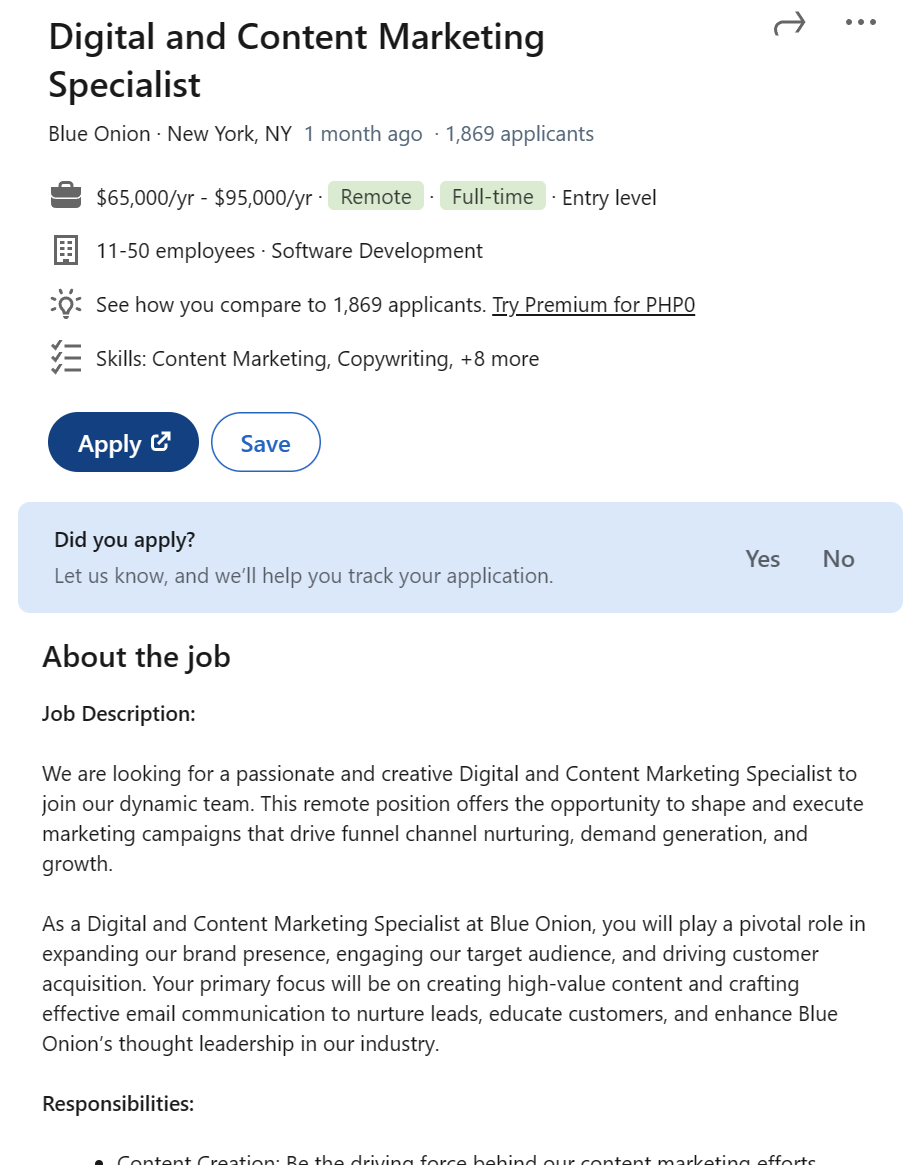
Image: LinkedIn
LinkedIn has a space dedicated to job listings, but it offers no room for visuals. Blue Onion, however, was able to maximize it by outlining all the details – from responsibilities to compensation – for their digital and content marketing specialist role.
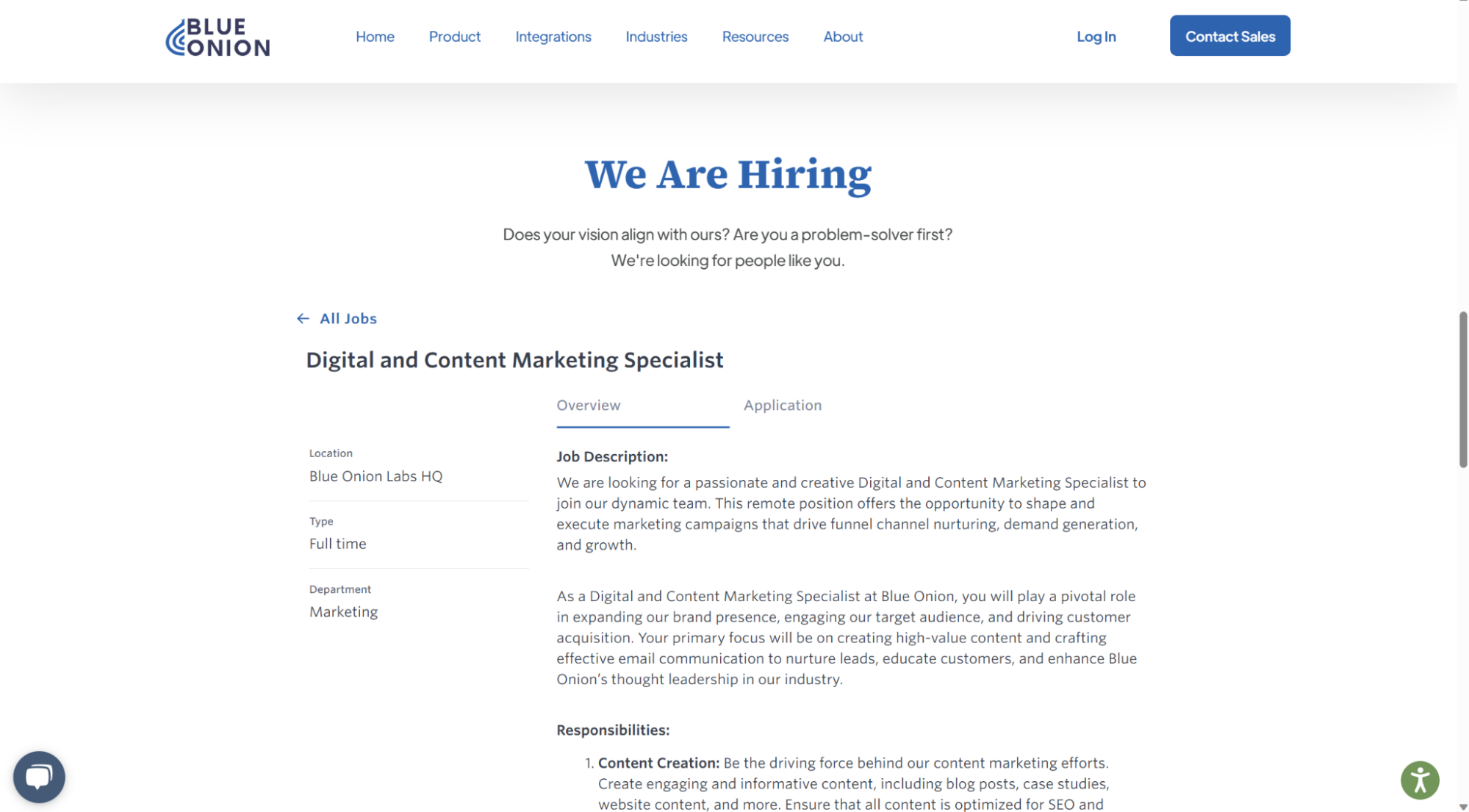
Image: Blue Onion
Clicking “Apply” then takes potential candidates to a landing page dedicated to the open position where they can begin the application process.
Facebook and Instagram
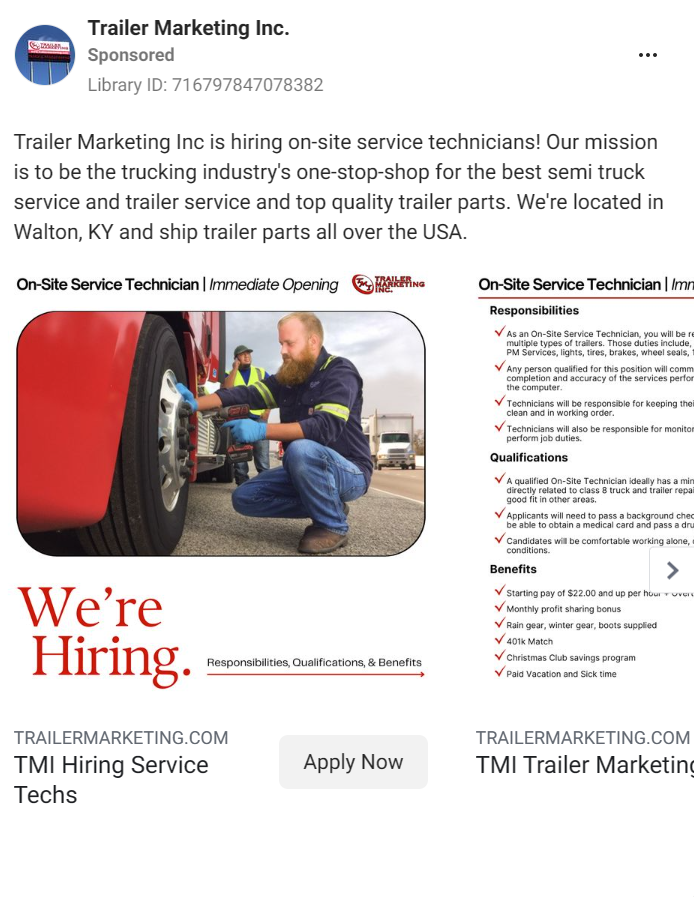
Image: Meta Ad Library
Trailer Marketing Inc.’s job listing for an on-site service technician demonstrates effective use of images that immediately outline what the job involves, as well as its benefits and requirements.
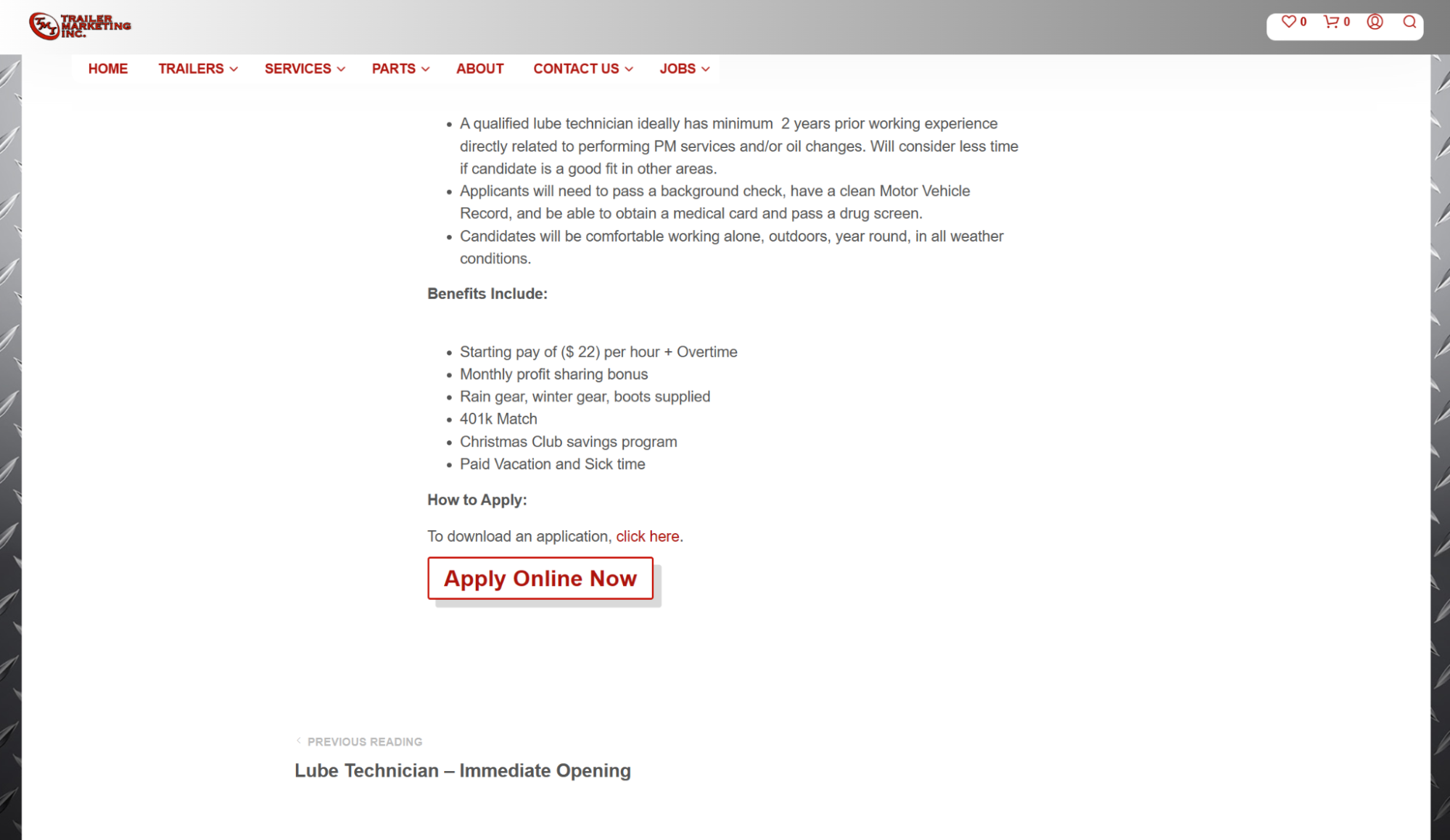
Image: Trailer Marketing Inc.
Interacting with the post then takes people to a landing page that reiterates all the position’s details, and hitting “Apply Online Now” transfers applicants to a form they can fill out and submit.
Twitter or X
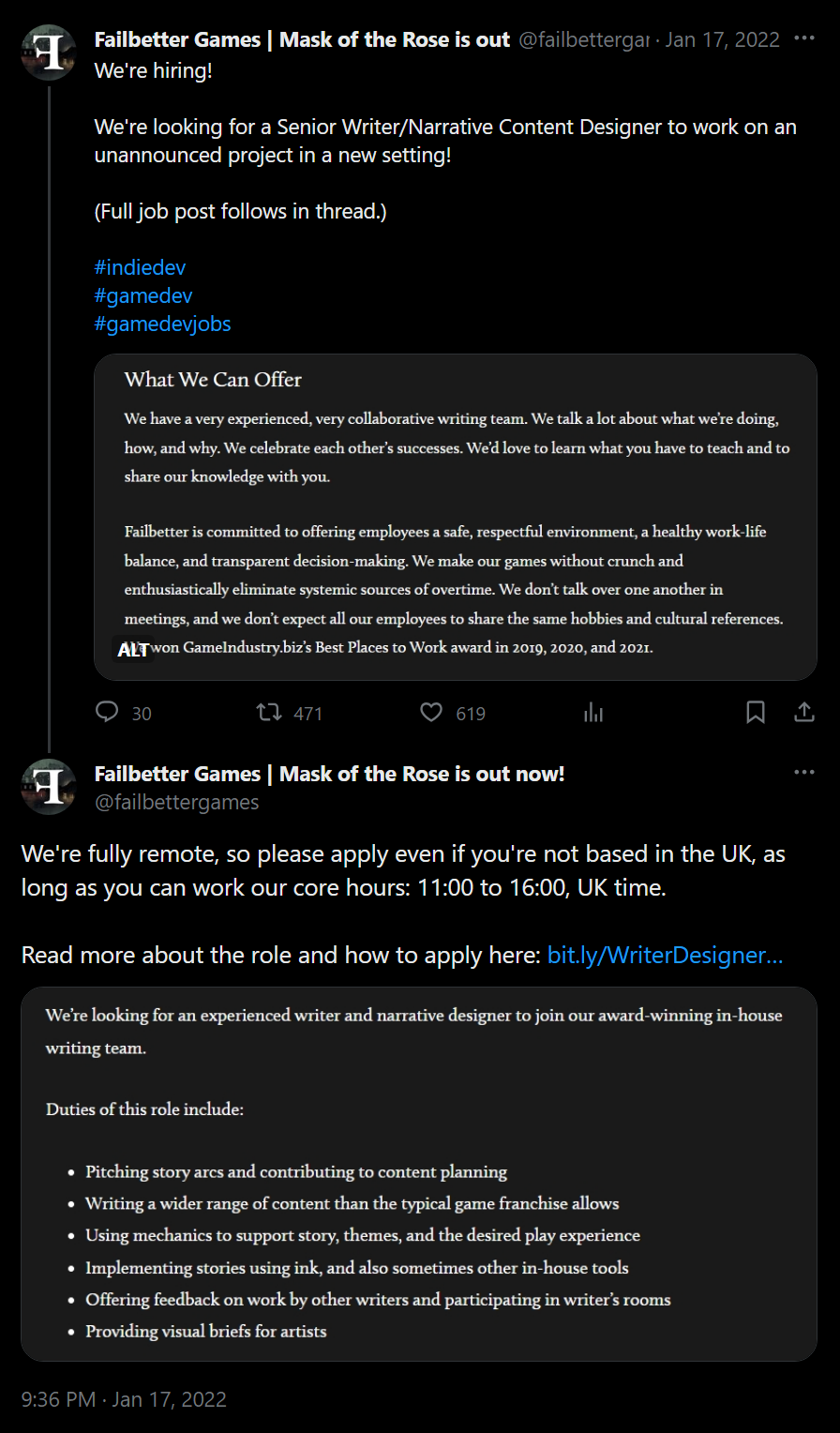
Image: Twitter
Failbetter Games effectively employs a Twitter thread for their writer/narrative content designer role. The brand clearly explains how they conduct business and treat their employees, then provide details about the position.
Clicking on the link takes prospective candidates to a page built for the application process. Here, Failbetter Games includes hashtags appropriate for the space.
YouTube

Image: YouTube
Google’s YouTube video documents their interns’ first week at work. Throughout, interns talk about their initial impressions of the company and how excited they are to work for it.
Managers are also included, and viewers learn a lot about Google’s culture, how people are treated, and how the company mixes fun in with employees’ daily responsibilities. Overall, the video delivers the strong message that Google provides an enticing environment.
TikTok
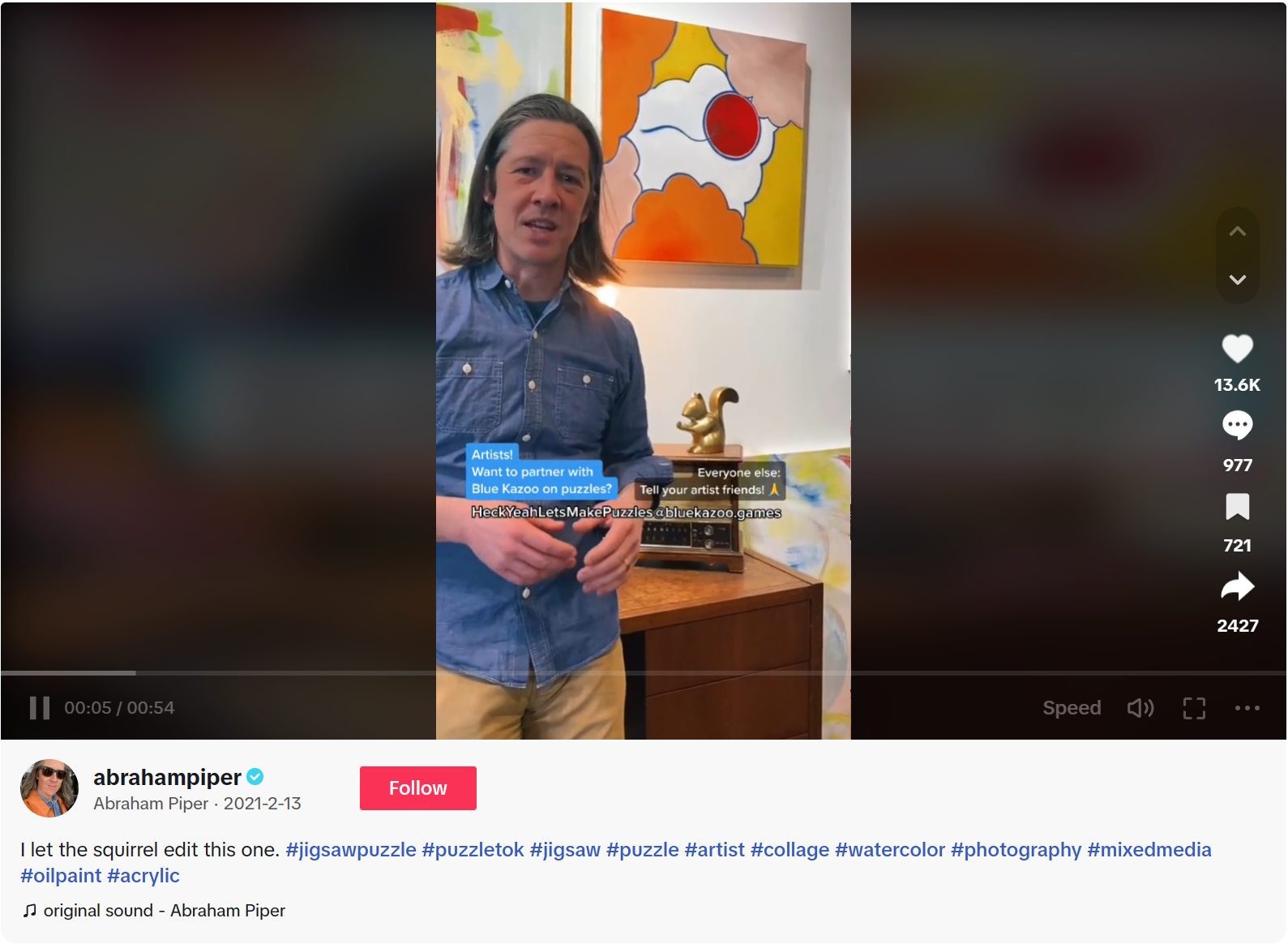
Image: TikTok
One of Blue Kazoo’s founders, Abraham Piper, leverages TikTok to reach out personally to followers and artists who can help the company design puzzles. His video explicitly outlines the art style he’s after, how artists can reach him, and then asks them to send pictures of their work.
In less than a minute, Piper is able to grab the viewer’s attention and communicate what the brand needs. He generously uses relevant hashtags as well while showing how Blue Kazoo’s leaders play an active role in the company’s success.
Wrapping up — Social media recruiting is challenging but worth it
Finding talent through social media can be a challenging process, but the outcomes are rewarding. To make the most of this channel during your hiring process, be sure to:
- Personalize your efforts and select platforms based on your audience
- Show genuine interest and respect when reaching out to candidates
- Avoid spamming people and groups
- Regularly update your company’s profile
- Incorporate visual and engaging elements
- Streamline the process for the best candidate experience
Although you shouldn’t base hiring decisions solely on your candidate’s online presence, you can glean valuable information from their social media activity. Use that information to pool your talent and find your next star employee.




